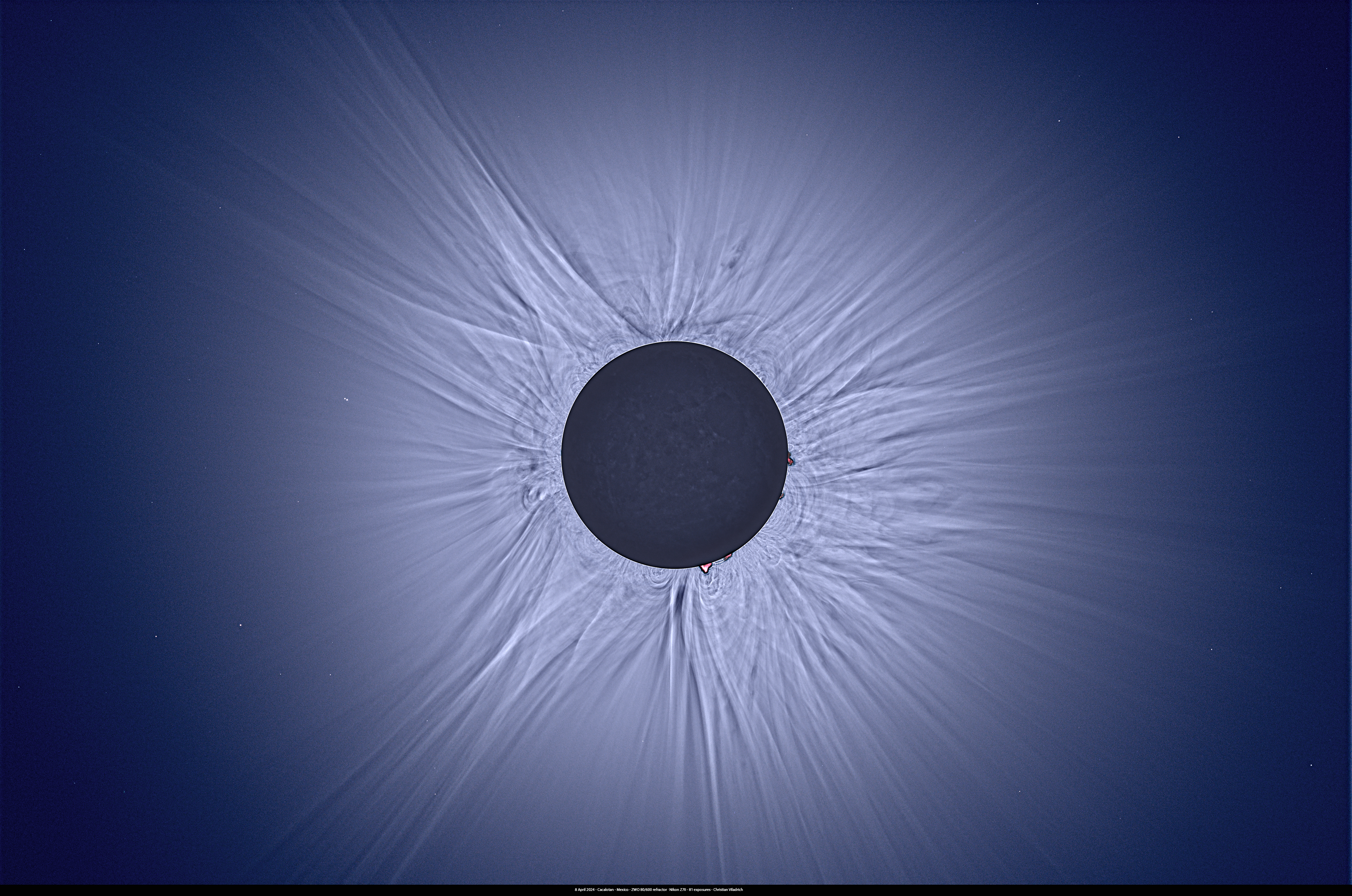8 April 2024
Cacalotan - Mexico
Local circumstances
Location : North +23° 04' 03.87", West 105° 50' 31.24"
Duration of totality : 4mn 14s
Conditions of observation
Equipement :
ZWO FF 80/600 refractor (continuous check of focus up to about 5 min before totality).
Nikon Z7II, 14-bit RAW mode (non destructive compression),
electronic shutter mode. Pixel size = 4.35 micron. Image
scale = 1.5 arsec/pixel
Exposure times for totality : 1s to 1/250 s (9 EV bracketing at 1 EV interval, 9 frames taken in burst mode at 3 s interval)
Mount : iOptron HAE29EC.
Seeing conditions : cirrus of variable thickness.
Estimation of the resolution :
Star FWHM on RAW images = 2.8 pixels (= 4.2 arsec).
1) Pre-processing
- flat/offset correction,
- hot pixels correction (home-made Julia code).
2) Registration of the image on solar corona
- registration of images on solar corona using zdeta Psc (mag 5.2) position (measured to 0.1 pixel) and correction of differential motion Sun/stars (based on ephemerids at local observation site).
3) HDR processing
- home made Julia software,
- calculation done in floating 64-bit, output fit file saved in 32-bit integer,
- image weight function = sinus function (except for 1 s and 1/250 s exposures),
- sensor response function is assumed to be linear.
4) Display of HDR image
The basic idea is :
image_visu = HDR_image / [gaussian (HDR_image, sigma) + constant]
- a large value sigma increases the visibility of long streamers and large scale structures away from the solar center (and decreases apparent noise in the resulting image),
- a small value of sigma is more appropriate to increase the constrast of small scale structures near the solar limb (and also reduces Gibb effet near the solar limb),
- the constant increases/lowers the effect of the gaussian mask.
The color images displayed here are the result of using a variable value of sigma (from 10 pixels to 30 pixels) as the distance r from the solar limb increases.
Star FWHM on RAW images = 2.8 pixels (= 4.2 arsec).
Processing of the image of totality
1) Pre-processing
- flat/offset correction,
- hot pixels correction (home-made Julia code).
2) Registration of the image on solar corona
- registration of images on solar corona using zdeta Psc (mag 5.2) position (measured to 0.1 pixel) and correction of differential motion Sun/stars (based on ephemerids at local observation site).
3) HDR processing
- home made Julia software,
- calculation done in floating 64-bit, output fit file saved in 32-bit integer,
- image weight function = sinus function (except for 1 s and 1/250 s exposures),
- sensor response function is assumed to be linear.
4) Display of HDR image
The basic idea is :
image_visu = HDR_image / [gaussian (HDR_image, sigma) + constant]
- a large value sigma increases the visibility of long streamers and large scale structures away from the solar center (and decreases apparent noise in the resulting image),
- a small value of sigma is more appropriate to increase the constrast of small scale structures near the solar limb (and also reduces Gibb effet near the solar limb),
- the constant increases/lowers the effect of the gaussian mask.
The color images displayed here are the result of using a variable value of sigma (from 10 pixels to 30 pixels) as the distance r from the solar limb increases.
Mid-exposure = 18:11:31 UT
9 x 9 exposures from 1/250 s to 1s (at 1 EV interval), total exposure = 18 s
Version 1

Link to full-resolution image
Stars are visible to mag 11.4
Version 2

Link to full-resolution image
Motions in the solar corona
Blink of two HDR stacks taken on 18:08:37 UT and 18:11:45 UT (i.e. about 3 min apart)

Click on image for zoom 50% animation (7 Mo)
Click here for zoom 100% animation (35 Mo)
Notes :
- 1h and 5 h directions : dark voids going downward,,
- 11h, 9 h and 5 h directions : expanding streamers,
- 9 h direction : expanding bubble.


